
After facilitating the two-day E-mediat Networking Conference, “New Media for the Networked NGO” in Jordan at the Dead Sea last week, I flew 2,000 miles west to Fez, Morocco to facilitate and keynote a second two-day conference for NGOs from Tunisia and Morocco that had successfully completed the e-mediat program in their countries, Morocco and Tunsia. The conference in Morocco was a “tri-lingual event” and was translated into French, English, and Arabic, although the content and instructional design were identical to the event in Jordan.
Both conference marked the end of an 18-month capacity building program that trained more than 220 NGOs in Jordan, Lebanon, Morocco and Tunisia on how to use social media effectively to advance civil society goals. (See the above video, created by team in Tunisia, which summarizes the program.) The project kicked off a year ago with a seven-day Train the Trainers intensive in Beirut, Lebanon for the in-country teams who would localize and implement the curriculum for five 3-day workshops that I designed. The networking conference was an opportunity for participants from different countries to share their lessons learned and network with one another. It was also an opportunity for me to co-facilitate with in-country team, meet the NGOs and hear their stories first-hand, and learn a lot about modeling and adapting interactive training techniques for different cultures.
For example, you can hear the story about how the above Tunisian NGO went from “crawling” to “running” over the course of the program.
This blog post is a summary of reflections about the instructional design and how NGOs in these countries are becoming Networked NGOs.
1. Facilitating Tri-Lingual Events: Not Lost in Translation

The conference was conducted in three languages: English, French, and Arabic. Materials were available in three languages, including printed worksheets, the program book, and we used two screens to project the powerpoints in English and Arabic. Ahmed Hamza, the training coordinator in Tunisia, who speaks all three languages fluently, helped with last minute translation tweeks and with flipping slides in Arabic.
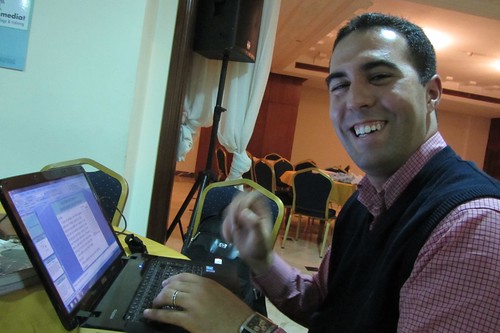
Participants had digital copies of the powerpoints translated into french and used their laptops to follow along. We used real-time translators and participants used headsets to tune into the language channel of their choice to understand what was being said.

This conference was designed as an interactive, networking event. While there were traditional panels and presentations – one-way broadcast style communications which are the best fit for simultaneous translation, I also facilitated large group discussion that required some slight pauses between interactions and repeating instructional logistics but with the very capable translation team and co-facilitating with the in-country trainers it ran smoothly.
Advanced preparation is important. All the materials were translated and provided to the translation team one month in advance so they could review the materials. When you’re facilitating a workshop with translation, it is important to speak slowly and pause and repeat phrases. You have to speak in “simple English” and be very aware of jargon. It is also important to introduce yourself to the translation team and work out some signals in advance. We worked out the following:

My translator is understanding what I’m saying

My translator is asking me to slow down

My translator is not understanding what I’m saying.
I’m pleased to say that I did not get the 2nd or 3rd signal at all! Another tip that the translators suggested that worked really well was to repeat exercise directions twice. In addition, we had the in-country team leader from Morocco, Widad, translate the instructions a third time. This was important because we were using a lot of interactive techniques like world cafe and speed geek that may have been new ways of learning for some participants.
Here’s an interview with the translators about best practices for facilitating training activities that need to be translated.
2. Design for Flexibility
The conference was a mix of content delivery and interaction, a mix of introducing new ideas and review from the 18 month program, as well as a mix of formal presentations and informal networking opportunities. Some sessions were designed as a workshop that included a presentation of a concept followed by a structured exercise and worksheet. Some new ideas that I shared included content curation, integrated content strategy, and measurement. The in-country team participated as co-trainers and facilitators served as our eyes and ears when there were small group exercises to help keep everyone stay on task and help me read the room..
We added a lot of buffer into the timings for each section as well as the ability to modify the amount of time spent on different exercises to compress the activity or do it to its fullest. This took paying a lot of attention to the group, the clock, and relying on the fantastic in-country team to help read the group.
3. Showcase Panel
The opening session was a formal session that included a welcome from IIE, a keynote by me, and a panel discussion where participants from each country shared a case study about how they applied what they learned in the workshops. For these types of projects, it is important to include an opening ceremony that is more structured and formal because often this is what the press and in-country VIPs will attend. And, indeed we had journalists present.
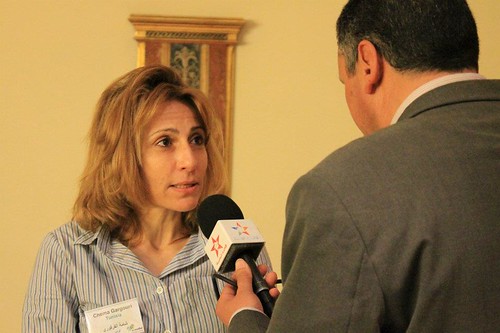
- Chema Gargouri, In Country Director, Tunisia being interviewed by the local radio station in Fez, Morocco
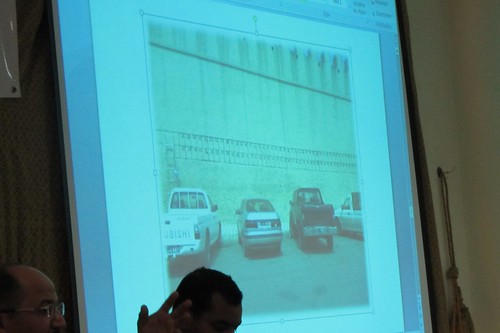
In the photograph above, Jael Jomma, President of the Association of Human Development in Kairouan, Tunisia spoke about a campaign and other NGOs in the city implemented to take off the election posters from the ancient walls of the Medina. Facebook was critical in their strategy. As Jael said in his remarks, “We need to be on the social media train, especially in post revolution Tunisia where Facebook is as common as the local radio. My father, who is over 70 years ago, uses Facebook to keep up with the news as well as our family.”
4. Networking Opportunities
It was very important to also include as many informal networking opportunities for participants to from Morocco to share their lessons learned with their colleagues in Tunisia. We mixed these more informal ways of peer learning with structured peer learning. Here’s what we did:

Participants were given a networking card and had to meet five other people from another country and find something in common and write down the information on the card. They were given 20 minutes to complete this task and submit their card into a box for a drawing of “good stuff” we brought from San Francisco, such as chocolate in a Cable Car box and copies of my book. We did drawings at various points throughout the two days, mostly as a device to get people to return from the coffee breaks (they had to be present in the room to win the prize.)
5. Informal Peer Learning and Sharing
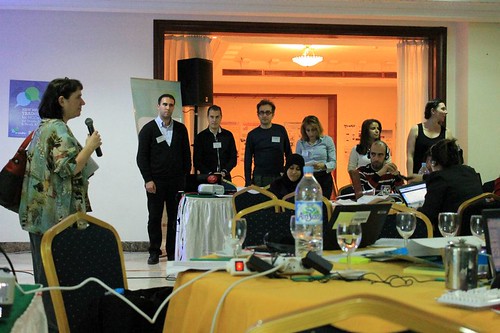

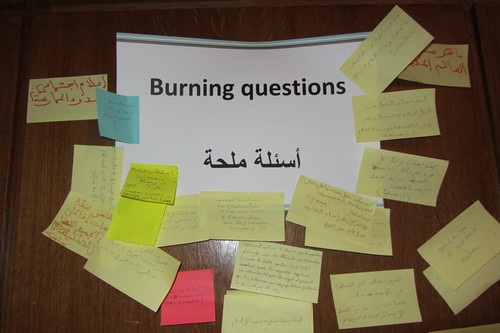
We also had several sessions that were designed as informal peer learning opportunities, using modified world cafe, speed geek sharing, and peer assist. In each of these sessions, we involve the in-country teams as the small group facilitator for the session. These sessions were focused on sharing best practices and tips for using social media effectively. The peer assist session was designed based on the sticky notes of questions that participants wanted to address.
6. Poster Sessions

As part of the workshops that were delivered, participants created posters that summarized what they learned and their results. The NGOs brought their posters and we had a mini-exhibition so participants could review each others posters and spark conversations about practice during the breaks.
7. Localized Content Delivery

There were also several workshop sessions where new ideas were presented. We did a sessions on measurement, integrated content strategy, and content for blogs. For these sessions, we localized the materials with in-country speakers and presenters. For example, I had an opportunity to co-present a session and exercise with Widad El Hanafi, Country Director for Morocco.
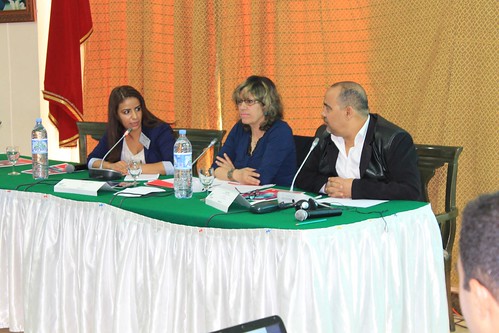
We also had a session on creating blog content as part of the integrated content strategy featuring Adel Nagatti, a blogger from Tunisia and Khira Arab, a well known blogger in Morocco. Both shared tips and practice advice.
8. Spreading the Seeds of New Ideas: Content Curation
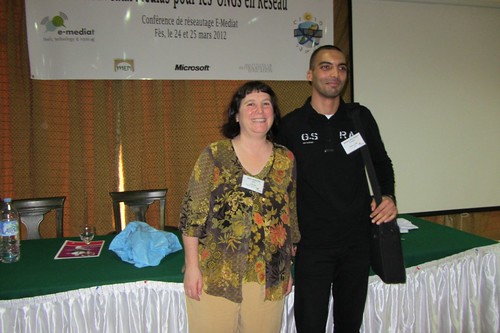
I did an interactive lecture on content curation, one of the new ideas to be introduced. I was delighted to have an opportunity to chat with Ahmed Bn who is aspiring to be the best content curator in Tunisia to curate content related to NGOs and Tunisia and Social Media. That’s one of the most exciting parts of doing work like this – sharing new ideas and seeing them localized.
9. Localized Energizers
At the Morocco, we did an after lunch energizer game where participants were invited to sing their national anthem and another end of the day energizers where a participant from Tunisia lead us in a much loved song about the “smell ” of the country which is Jasmin. It is one of the reasons the Tunisian revolution was referred to as The Jasmin Revolution. In Jordan, we did the Debka, a Lebanese dance. With International trainings, it is always fun to have participants share a song or dance from one’s home country.
10. Quiet Reflection: Socoot

One of the Arabic words I learned was “socoot” or quiet. One closing exercise I always do at workshops is give participants an index card and 60 seconds of quiet to think about one idea they can put into action after the workshop. It was amazing to have a full moment of silence for participants to reflect and pick out something they plan to use in their social media strategy or techniques.
11. What does it mean to be a “Master Trainer?”

My role in this project was “Master Trainer,” which over the 18 months included training the trainers, providing support over the Internet, and co-facilitating this culmination event. It was an amazing opportunity to learn – not only the content of how NGOs can become networked NGOs but also a chance to transfer training design and delivery techniques. I look forward to seeing great things happen with NGOs and social media in Morocco, Tunisia, Jordan, and Lebanon — and now for some much needed rest.
